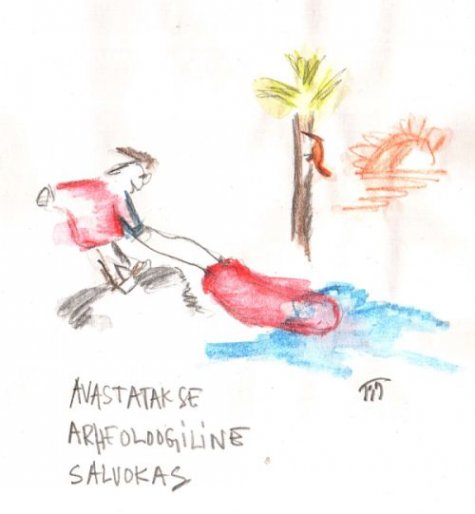Backyard potter's tales
Backyard Potterer’s diary: May
Illustrated and written by Tiit Kändler
Translation: Liis
Discovery of the archaeological Salvo sliding sled
Potterer’s diary: May
May 5th
The potterer decides to organise a Backyard Saturday – as he usually does at this time of the year. The flooding of the land strip bordering to the Treppoja creek has receded and as every year, left as memorial nature objectified by man. A beer bottle that has sucked itself full of mud. A piece of a sadly empty chips package. A foam plastics clump direly needed to secure something. Bits of a red sliding sled that once happily slid along ice paths but now shamefacedly has dug itself into the creek sand. When were they last sold? Surely in that time, if not many human generations, then certainly several generations of squirrels, woodpeckers and bullfinches have grown up. Should the find, dragged out of the water and mud, be offered to the Estonian National Museum, the Seaplane Harbour museum or after all just be tucked into the large blue thrash bag and lifted outside the gate to wait for removal transport? The Potterer decided in favour of the last-named.
May 6th
It is incredible how fast brushwood grows at an immeasurable rate. In the few years that the Potterer has not pulled out the bird cherries and rowans, maples and raspberries now stretching towards sky, they have already changed into a stately coppice edging the ditch bank and the garden fence. When does a tiny sprouting tree-to-be become a coppice? We want to see the forest beyond the trees but don’t think it worthwhile to see the coppice beyond the shoots. May the coppice cop you, forest fall on you.
May 13
The Potterer feels that he should make a fire, feed it with the brushwood and branches and last year’s leaves. The smoke from the neighbouring yard’s fire penetrates into his nose although the fire is not within sight nor sound. The nose is more powerful than eyes, however sharp, and ears, however sensitive.
But there is nothing new in that feeling. Analysis of charred bones and bone ash in South African deposits suggests that Homo erectus busied himself with firemaking millions of years ago and maybe even baked a meal for himself on it.
Mastering a fire triggered an evolutionary revolution. Aided by it, climatic changes could be countered – warming up was possible as it got colder - and from food also more necessities could be extracted and so more people could be fed. It took less time, more energy was obtained – it was possible to have more children and in the time left over from hunting food, to concern oneself with this and that that could make one’s brain grow.
According to common belief the first fire was kindled 400 000 years ago and it was done by the Neanderthals as well as modern man. Fossil bones found in South Africa in a Northern Cape Province cave tell that they have been heated above 400 degrees Celsius. The bones were found in the cave at a depth of 30 metres suggesting that they were buried. Even 1,7 million years old burnt bone shards were found.
Thus hominins might have invented fire before modern man. An ugly story. If they had not invented the fire, we would not have to make fires now or heat our houses or waste money on it. Even more – we would not have houses nor even Facebook. We wouldn’t be us. We would not have our backyards.
After this reasoning evening has arrived and he has no more energy left for fire-making.
May 18
The squirrel comes and looks at the Potterer sitting behind his computer behind the window glass. Where are the nuts that were in the feeder even yesterday? The woodpecker flies in and repeats the squirrel’s demanding look. Then comes the bullfinch: where are the seeds? How to explain to them that it is May, the large bird cherry stands proudly full of blooms. But actually it isn’t and outside the window everlasting autumn reigns. But autumn may gloat, spring still manages to edge through. How old is this power of the yard beings to impose their will, whatever the weather - or even the climate icier or hotter? The further you look, the more ancient the yard-dwellers get.
Indeed, the more gene technology evolves, the older species get. So for instance new genetic analysis shows that polar bears split from their nearest relatives 600 000 years ago. Thus they are five times older than believed previously. The polar bears have had much more time to adapt to arctic conditions than thought earlier. At the time when the polar bears diverged, the coldest period of the Pleistocene occurred which may have given the evolutionary nudge to polar bears to turn into the creature that we know today – and that we try to protect. Why do we protect the polar bear but not the pre-polar bear?









